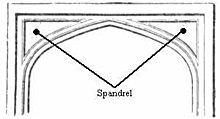spandrel
English

Alternative forms
Etymology
From a diminutive of Anglo-Norman spaundre, of uncertain origin, perhaps from Old French espandre (“to expand, extend, spread”). In the biology sense first used by Stephen Jay Gould and Richard Lewontin.[1]



Noun
spandrel (plural spandrels)
- (architecture) The space (often more or less triangular) between the outer curve of an arch (the extrados) and a straight-sided figure that bounds it; the space between two contiguous arches and a straight feature above them.
- Coordinate term: pendentive
- (architecture) Horizontal member between the windows of successive storeys of a tall building.
- (architecture) The triangular space under a stair; the material that fills the space.
- An oriental rug having a pattern of arches; the design in the corners of such a rug, especially in a prayer rug.
- (evolutionary theory) A phenotypic characteristic that evolved as a side effect of an adaptation in response to evolutionary pressure.
- 2009, Anna R. Kinsella, Language Evolution and Syntactic Theory, Cambridge University Press (→ISBN), page 13:
- Another type of theory emphasises the sometimes accidental nature of evolution. A spandrel is a structure arising as a by-product of some other architectural configuration. In evolutionary terms, a spandrel is some trait of an organism which emerges not through direct adaptionist or exaptationist means, but rather as a side effect of some other evolutionary development.
- 2009, Anna R. Kinsella, Language Evolution and Syntactic Theory, Cambridge University Press (→ISBN), page 13:
Derived terms
Translations
space between an arch and another object
|
See also
Further reading
 spandrel on Wikipedia.Wikipedia
spandrel on Wikipedia.Wikipedia  spandrel (biology) on Wikipedia.Wikipedia
spandrel (biology) on Wikipedia.Wikipedia
References
- ^ S. J. Gould, R. C. Lewontin (1979 September 21) “The spandrels of San Marco and the Panglossian paradigm: a critique of the adaptationist programme”, in Proceedings of the Royal Society of London. Series B. Biological Sciences[1],